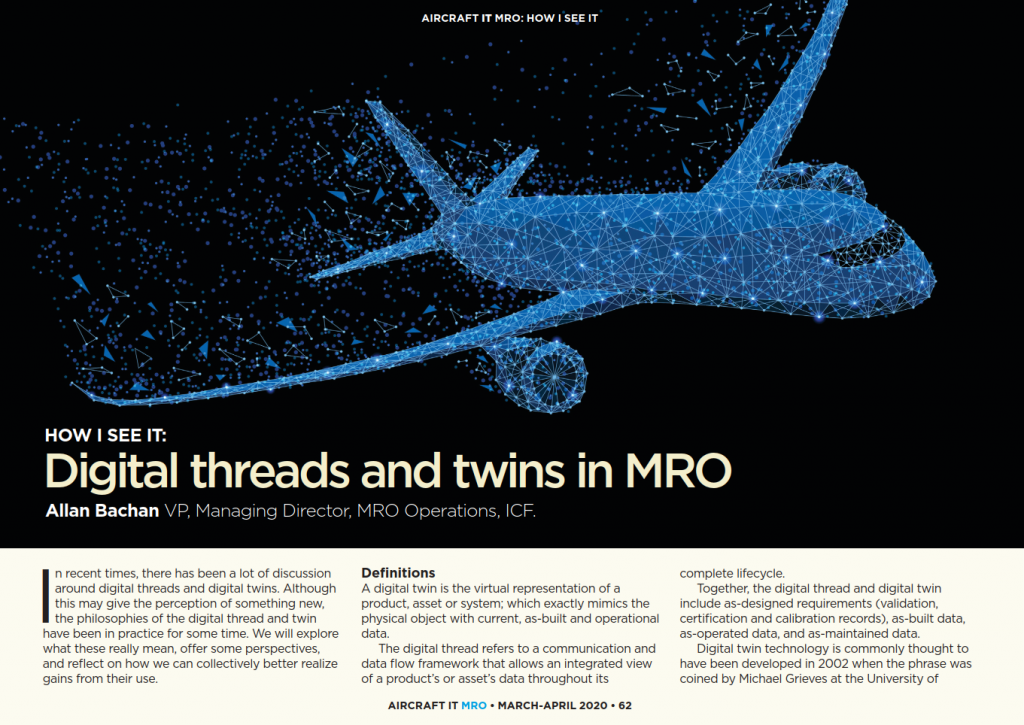Articles
| Name | Author | |
|---|---|---|
| Case Study: Achieving Zero Inventory with Hyper-Connected and Automated Supply Chain at AMP Parts | David Rieth, Director Business Development, Airline MRO Parts (AMP) and Manoj Singh, Sr VP & Head of Aviation in Americas, Ramco Aviation | View article |
| How I See IT: Digital threads and twins in MRO | Allan Bachan, VP, Managing Director, MRO Operations, ICF | View article |
| Case Study: Virtual Reality Training at FL Techncs | Ramunas Paškevičius, Head of IT and Innovations, FL Technics | View article |
| Solutions in Practice: Titan Airways uses CARDS Cloud Based Aircraft Transition Solution. | Dave Bunker, Engineering Director, Titan Airways | View article |
| Case Study: 100% On Time Performance through Mobility and Paperless Solutions at JAL Engineering | Yuki Nakai, Director IT Planning, JAL Engineering | View article |
| Case Study: Moving to a Cloud-based M&E System at Copa Airlines | Pablo Rousselin Avendaño, Senior Projects Manager, Copa Airlines | View article |
How I See IT: Digital threads and twins in MRO
Author: Allan Bachan, VP, Managing Director, MRO Operations, ICF
Subscribe
Digital threads and twins in MRO
In recent times, there has been a lot of discussion around digital threads and digital twins. Although this may give the perception of something new, the philosophies of the digital thread and twin have been in practice for some time. We will explore what these really mean, offer some perspectives, and reflect on how we can collectively better realize gains from their use.
Definitions
A digital twin is the virtual representation of a product, asset or system; which exactly mimics the physical object with current, as-built and operational data.
The digital thread refers to a communication and data flow framework that allows an integrated view of a product’s or asset’s data throughout its complete lifecycle.
Together, the digital thread and digital twin include as-designed requirements (validation, certification and calibration records), as-built data, as-operated data, and as-maintained data.
Digital twin technology is commonly thought to have been developed in 2002 when the phrase was coined by Michael Grieves at the University of Michigan. However, twinning has been a concept practiced by NASA since the 1960s. For example, this was how NASA was able to assess and simulate conditions on Apollo 13, which was over 200,000 miles away. Back then, the ‘twin’ was more of a physical rather than a virtual replica.
Arising from the development of the Internet of Things (IOT), from 2017 onwards, digital twins became even more pertinent and are prominently relevant today.
The phrase digital thread was coined at Lockheed Martin to describe using 3D CAD (computer-aided design) data to directly drive CNC (computer numerically controlled) milling or composite programming systems for carbon fiber placement. In both cases, the physical output is the result of an unbroken data link that originates from the original computer model of the respective part. The unbroken data path was the digital thread.
A consortium of aerospace and defense manufacturers gathered in 2011 to discuss the digital thread concept for the first time. The goal of their newly formed Computational Manufacturing Alliance (CMA) was to find common ground where both makers and users of the technology who needed to create a digital thread could work out data interchange issues.
The U.S. National Institute for Standards and Technology (NIST) is working with stakeholders in advancing the digital thread philosophy. It defines the digital thread as “a way for different machines in a manufacturing process to all follow the same set of digital instructions.” This is slightly different from Lockheed Martin’s original definition, but more holistic.
Applications
For simplicity in this context, we will specify the digital thread as that which is unbroken throughout the following cycle:
- Ideate;
- Design (or Engineer);
- Manufacture (or Produce);
- Operate;
- Maintain (or Service);
- Retire.
Aircraft design and manufacture has been paperless since the 1990s. For example, the Boeing 777 was conceptualized in 1990 and first rolled off the production line in 1995 using 100% digital blueprints.
A full digital thread from ideation through to the first flight and delivery of the B777 aircraft continues to be one of pride for Boeing. The B777 is also frequently dubbed the ‘most successful aircraft in aviation’. Throughout the protype production, and for all subsequent aircraft, digital twins with digital threads – up to Boeing’s handover to operators – have existed.
One observation in the realm of civil aviation is that the ideate, design and manufacture processes are more digitally mature than the operate, maintain and retire processes.
In fact, there is a noticeable drop in the digital thread maturity between the Manufacture and the Operate functions in the cycle and another between the Operate and the Maintain functions as shown below.

Needs
In a 2019 Cap Gemini survey of ‘Digital Aviation in MRO’ conducted through the Aircraft Commerce and AircraftIT community, three (3) measures stood out:
- 87.4%: “Current MRO IT solutions are average or below average”;
- 78.1%: “There is significant value from closing gaps in the digital thread”;
- 76.9%: “Value would be received if OEMs close the digital thread gaps”.
We can therefore conclude:
- There is a desire to improve current MRO IT solutions to “above average”;
- Improvements will come from addressing the digital thread;
- OEMs are seen as a key resource to the digital thread solution.
What we do note about surveys is that respondents may often state less than is actual either because they think achieving what’s real is improbable, or they do not know what they need until they see it.
A quick look over MRO IT system purchases over the past ten (10) years shows that there are more than 850 airlines globally which have made significant technology investments to modernize systems. Most of those airlines are hence now on systems that are still active in the marketplace which are still supported, enhanced and developed.
Are needs because those systems are still catching up to the digital thread or because the operators have not yet fully adopted such systems?
Is the perception that the OEMs are key contributors to closing the digital threads also thereality?
The OEMs are already very mature in making aircraft and engines. The real challenge is how can this translate to operations and maintenance.
So, is this not the key responsibility of the airlines, operators and MROs? Or, is it that it’s there – already provided by the OEMs – but they (airlines and MROs) do not yet see it?
Gaps
Digging further into the divide between Manufacture: Operate and Operate: Maintain, there are some things which are worth noting.
Operators have always focused on good Configuration Control and Maintenance Programs Management as important functionality when selecting MRO IT systems. We will confine our discussion here to just those two (2) aspects although there are numerous possible other gaps.
Aircraft Readiness Logs (ARLs) are now being produced automatically from RFID (Radio Frequency Identification) and AIDC (Automatic Identification and Data Capture) data on components already assembled into the aircraft. A typical Airbus aircraft has 5000+ and a Boeing aircraft has 7000+ such parts. The ARL is a key document which is handed over from the OEM to the operator. Enhanced data and new generation aircraft also include LSAPs (Loadable Software Aircraft Parts) information. These can be as many as 300 parts with 1400 software instances for a single B787 aircraft.
The ARL is vital to setting up an aircraft in any operator’s MRO IT system. How this is handed over and how it is ingested has many variations in actual practice across operators.
Operator standardization is lacking even with the same MRO IT system and the same aircraft type and model across organizations. For example, position assignments (or position codes) for the same part numbers on an Airbus A320 series aircraft configuration will differ between any two (2) operators with the same MRO system.
The current MPD and MRBR for any aircraft type are based on MSG-3 philosophy which is now 30 years old. The Maintenance Planning Document (MPD) and the Maintenance Review Board Report (MRBR) are key documents used to create the Operator’s Maintenance Programs (OMPs). Although ECM (Engine Condition Monitoring) and AHM (Aircraft Health Monitoring) have both been around for quite a while; none of the MPD tasks are of AHM or ECM type. Inbuilt sensors and data now change the nature and value of the tasks in the MPD and consequently the OMP.
Additional documentation and manuals delivered with aircraft, including the AMM, IPC, WDM, SRM, etc. will also vary by operator or maintainer in the way they are ingested and processed into internal MRO IT systems. Keeping up with revisions is often lagging and tasks source content would vary for any OMP. Some may have seamless linkages between manuals (for example, MPD task linked to OMP and AMM which in turn is linked to the IPC) or some may have pure PDF execution documents only.
The above demonstrates how easily the digital thread may be broken on key handovers from manufacturing to operations and maintenance.
It is possible then that we are trying to manage digital assets using conventional and traditional methods and system? Is there another way to look at this continuity issue?
Solutions
IP (Intellectual Property) between OEMs and the MROs is an ongoing discussion. In February 2018, IATA and CFM signed a pro-competitive agreement which allows licenses to use CFM manuals and repair methodology content even if non-CFM parts are involved.
In September 2019 Airbus announced that it would charge the MROs a royalty fee on top of access fees for using its Technical Data. This was quickly retracted when it was met with resistance from the industry.
Owning and controlling the service, maintenance, and upgrades for aircraft and associated equipment is big business that can last more than 20 years, depending on the product. At stake are millions of dollars of annual maintenance — either revenue to be gained by manufacturers servicing what they build; or expenses to be re-captured by owner-operators or MROs by gaining information needed to maintain their assets themselves.
Until there is openness, collaboration and sharing, this will continue to be an area of conflict.
From a systems standpoint, there is merit to looking at digital assets management from PLM (Product Lifecycle Management) and EAM (Enterprise Asset Management) standpoints since these have already been proven in the front-end processes. Inheriting the existing digital thread and twin for new aircraft deliveries may be faster and cleaner than re-creation in traditional MRO IT transactional systems. This is also related to how much IP the OEM will ‘share’ through the same IT systems. For certain, the vendors that support the MRO IT systems should also look at standardizing implementations for Configuration Control and Maintenance Programs.
Perhaps it is time also for an MSG-4 which acknowledges the amount of sensors, data, IOT and connected nature of aircraft.
For now, that how I see IT.
Simplify your choice. Book a free consultancy session with Allan to discuss the issues here, in greater detail and in the context of your business and challenges.
Contributor’s Details
Allan Bachan

Allan is a Vice President at ICF with 32 years of industry experience as an Aviation M&E, MRO and Supply Chain solutions and systems domain expert. He is responsible for ICF’s MRO Operations and IT practice and he manages the Aircraft Commerce Consulting relationship with ICF. His experience includes managing application design, development, and full cycle implementation – from selection to go-live – for strategic clients in the MRO industry using different commercially available MRO IT products. In his career, Allan has fulfilled the following leadership roles: MRO IT practice and technical lead; MRO systems Product Principal; M&E and MRO Solutions Director and Manager of Technical Records, Maintenance Planning and Production Control.
Comments (0)
There are currently no comments about this article.

To post a comment, please login or subscribe.